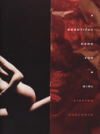A Beautiful Name for a Girl
“Girl-ness” matters a lot to Kaschock. Her bio begins: “Kirsten Kaschock was the second, and then the third of five children.” And the book opens with a character who might be a girl or a woman or a woman/girl: “This is the house that Jane built. // Jane begins by standing. Once this was / Jane finding Jane.” Or Kirsten Kaschock finding Jane. Or finding Kaschock. And the relationship between girl-ness and the pain of that essential self matters a lot to Kaschock, too, and is the foundation (think house) for the book:
“Girl-ness” matters a lot to Kaschock. Her bio begins: “Kirsten Kaschock was the second, and then the third of five children.” And the book opens with a character who might be a girl or a woman or a woman/girl: “This is the house that Jane built. // Jane begins by standing. Once this was / Jane finding Jane.” Or Kirsten Kaschock finding Jane. Or finding Kaschock. And the relationship between girl-ness and the pain of that essential self matters a lot to Kaschock, too, and is the foundation (think house) for the book:
—but now I am
in a unique position to feel pain. This is distinct
insistent now. Jane, Jane fraught. I have
more space for pain Above the primordial
flowering of was, a shimmer.
In its wake—structure: Jane is.
It is less space.
This is the house Jane built by being the house
Jane built by being. This is not
the good pain—pain
Jane stood to feel in origin of Jane
Instead, this is the pain of lean-to—
uncontaining. Mere stay
against exposure. This is all is left
a Jane. This is enough.
And there is, indeed, ample pain here, that particular pain of a disappointed wounded girl with the capacity to wound us all with her self-loathing. She is destined to suffer from the beginning, as predicted in “Baby Names: Girl F:”
FABLE the one you think would go on, but circles back, her daily calls almost a
nuisance—wasn’t she supposed to do something special?
…
FYNE what you eventually named her—resigned to predicating her ruin
It’s not merely that girls are expected (but fail) to be special, but that they are, by their very girl-ness, bad, wrong, strange (and oh, how I wish these ideas really were strange, rather than part of the common experience of so many, if not all, girls), as in these lines from “Old Doll Baby”:
They think mine
a prettypretty blank blank
…
If they knew the same they’d love it like a root
but would want to get away—if the same
were true for them
day in, day out—their fingers would stop
no prettypretty holes down there
They don’t know what that’s like
everything in and nothing let
inside my forgotten space—cotton
The girl who feels she is already, at birth, less than expected or less than she should be, once “Sold into Performance,” continues to disappoint:
I never sang—I danced but no solos.
I was legs in the frog chorus, at that time strictly
Platonic. You want to put me down as a leading lady when I was so much
less.
Performance is an important component of this book—Kaschock is, in fact, a dancer—and girls (women) as performers (performers who act as a result of or who can inspire pain), the act of performing, and the arts are persistent themes and images: an aging Marlene Dietrich (“Marelene Dietrich at 70 Had Legs That Shot to Heaven”); a long choreographed poem titled “Snuff Ballet (A Monologue for 2, 3, or 7)”; a prose poem elucidating the poet’s poetics (“Angel, Boxed: A Poetics”); and a poem about music (“Quartet”). “Snuff Ballet” is particularly intriguing (and painful), complete with stage directions, notes on the cast, the set, costuming, music, and the ballet’s plot. The poem begins with nearly three-dozen questions in italics:
Why a one-woman show/ Tell us—is this performance art?
Can it be somehow about surgery?
How will the audience sit through two hours of her?
Despite their more seemingly universal importance (“Have you considered Hiroshima?”), no other question is as significant as: how can we tolerate “her?” Here is that (performing) girl again, unworthy of our attention, yet demanding it anyway. (How can we read her?)
Kaschock is inventive, creative, and original. Her lines are often exquisite, her syntax not impenetrable, but not typical, a careful and artful choreography. And her work is as uniquely pained and painful as any I have ever read. Every time I picked up the book to review it, I had to put it down again, I was so overcome with anguish and grief and sorrow. So much weeping (“The song weeps because this one child was never born. / There were other children; there were even girls.”). So much moaning (“Oh my head, my / head. My moan flower.”). So much lying (“If she would have a daughter, I would be / that daughter. No that, / would be a lie. In truth I am / a march of lies.”). So much raw distress (“I sang to the muscle even as it grew / ashy. The song was continuing pain.”) So much diminishment (“During the same period, I have shrunken to the size of a petri dish”). So much grief (“It is purple, a day about lettuce. A day to get / the grief across. I open the corpse / with a letter opener.”) So much loss (“why does it matter where I am losing my // self, to whom?”).
In a long poem ostensibly about Houdini (“Houdini Dies. I Teach His Obituary”), the poet advises: “Write your own obituary: write it about someone you admire.” I admire Kaschock, despite—or perhaps because of—the intense pain she so artfully performs.





